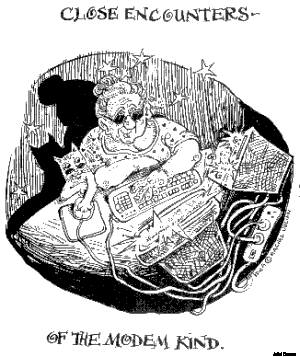Summer 98
Part 1Part 2
Part 3
Part 4
Part 5
Part 6
Part 7
Part 8
Part 9
Part 10
Part 11
Part 12
Part 13
Part 15
Part 16
SITE MAP
ABOUT US
PAST ISSUES
LETTERS
SUBSCRIBE
COPYRIGHT

Reviews
by Jo Sutton
Book
Internet Resources on Women: Using Electronic Media in Curriculum
Transformation
by Joan Korenman, 1997,
published by the National Center for Curriculum
Transformation Resources on Women,
Towson State University, 8000 York Road,
Baltimore, MD 21252, USA.
I often work with a book or magazine by the keyboard, still dependent on paper and print. Joan Korenman has now provided an excellent book, in both size and scope, to consult with and place beside your computer. Her guide to successfully using the Internet is concise and very useful. Her explanations are clear and succinct, starting with email, where she even offers some troubleshooting for delivery problems. Along the way she makes some important points about the value of the Internet, such as “It brings to the center people whom our society too often relegates to the margin”.
Joan’s book does not assume that you have all the technical bells and whistles on your computer. She offers a variety of ways to work online, such as gopher, and ftp (File Transfer Protocol) as well as “You’ll find that even with an old computer and a 2400 baud modem (a very slow modem), you can still access the Web”. The book offers further reading and resources, including a Web site where updates on this book can be found. She even manages to add humour, a considerable asset in a guidebook.
Joan Korenman’s work is widely known and acclaimed by women online, particularly for her Women’s Studies Mailing list (WMST-L) and her University of Maryland Web site - (see Page 10 in this issue of Women’space) . Now she has put together her online work with her offline achievements. It makes for a great combination.
Article
“Women and Girls Last: Females and the Internet”
by Janet Morahan-Martin
Need a detailed set of arguments why we should ensure women and girls are
included in the new technologies? Want to have a large range of references
which support those arguments? All this, without the woman blaming, can be
found in a paper written by Janet Morahan-Martin at
sosig.ac.uk/iriss/papers/paper55.htm
[no longer accessible at this address]
Starting from “Low Internet use by females not only gives them less access to information and services available online, but also can have negative economic and educational consequences.” this paper goes on to elaborate some of the barriers to Internet access and use for women and girls. Morahan-Martin points out that while the number of women online has increased dramatically, the data is often contradictory and that we still depend on estimates. What we all know for sure is that women are still in the minority online, stay online for less time and that young white males are online the most. “Boys spend more time on the computer at home than do girls, and parents buy twice as much computer-related products for sons than daughters”. She shows that computer games are much more oriented to boys in both content and sales. Her summaries and discussion of surveys of online discussion groups show that men and women communicate differently, and in ways that support earlier work on male domination of communication in many mixed groups. She points out that “A commercial study of what women want online found that women want their own communities” and goes on to urge that future research on the Internet include the impact of gender and culture.
This paper is, as you will have noticed in the URL, number 55. It’s the
one which stands out for me, in the online collection of some really
fascinating papers from a Social Science conference in March 1998 in
Bristol, UK.
www.sosig.ac.uk/iriss/
| Top |
Part 1 |
Part 2 |
Part 3 |
Part 4 |
Part 5 |
|
Part 6 |
Part 7 |
Part 8 |
Part 9 |
|
Part 10 |
Part 11 |
Part 12 |
Part 13 |
Part 15 |
Part 16 |
Home |